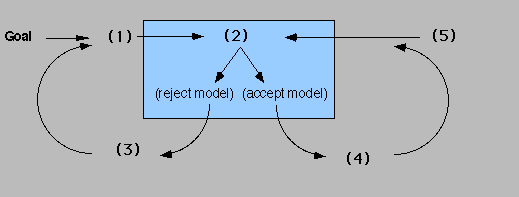1-6. Label the parts of the following graph of the scientific method.

Possible Answers
1. What part of the scientific method does (1) represent?
2. What part of the scientific method does (2) represent?
3. What part of the scientific method does (3) represent?
4. What part of the scientific method does (4) represent?
5. What part of the scientific method does (5) represent?
6. to 10. In each of the following indicate which parts of the scientific method are present. Mark only those parts of the scientific method that are explicit in the problem description.
Parts of the Scientific Method
6. The U.S. Forest Service is given the task of managing Forest Service lands for multiple uses (e.g., lumber, recreation, conservation). As with any government agency, there is an elaborate set of regulations that must be followed in pursuing this charge, and of course, there is also an informal set of procedures that is and has been used to conduct this business. But this agency does not implement any procedure to consider what kind of job they do or how they might improve execution of those duties.
Answer: Goal and model are present. The goal is the task ostensibly assigned to them (manage the lands). The model is their set of procedures for implementing their duties. But they do not gather data on their performance nor evaluate whether their procedures are actually doing what is intended, so the latter 3 steps of the scientific method are absent. It is in fact typical of government agencies that no provisions are made for evaluating and improving their performance.
7. A car mechanic is given a 1966 Mustang to fix. The owner's complaint is that the engine runs roughly, especially when the car is accelerating. The mechanic's first guess as to the source of the problem is that the fuel mix is too rich. After adjusting the fuel mix valve, the problem persists, so the mechanic then guesses that the sparkplug advance mechanism is faulty. Replacing the sparkplug advance mechanism (the diaphragm attached to the distributor) fixes the problem, and the fixed car is returned to the owner.
Answer: All elements are present. The goal is clearly defined as fixing the engine trouble. The first model of the problem is the mechanic's first guess (fuel mix problems). Data are the observations made after adjusting the fuel mix, and evaluation is the mechanic's observation that the problem remains. Revision is the mechanic's second guess (sparkplug advance).
8. To determine the most effective sales strategy, consumer goods retailers sometimes do experiments. These experiments help the retailer understand how people decide what to purchase. For example, the retailer can change whether a product is displayed on a high or low shelf, or can change which products are displayed nearby. The retailer then analyzes these data, and changes their product displays so as to maximize sales.
9. To understand the AIDS epidemic and develop improved ways of controlling it, scientists use mathematical descriptions of the epidemic.
10. The typical university class is intended to convey specific information to the students enrolled. The usual format for conveying this material involves lectures and reading material which the students are expected to learn. The extent to which students actually succeed in learning the material is determined from exam scores.
Answer: The first four features of the scientific method are present. However, it is not commonplace for instructors to revise their teaching methods in response to poor class performance. Instead, a grading curve is implemented or future exams are made less difficult to increase the average score. In other words, evaluation serves to change the instructor's expectations but does not change the instructor's teaching methods. In fact, use of the scientific method in improving teaching is even more non-existent than is evident in this simple example. Instructors almost never evaluate student knowledge at the beginning of class, so they cannot evaluate what the student has learned, rather they can only evaluate what the student knows. The common assumption is that students don't already know the material being taught, but that assumption is obviously and often false.
Table of contents